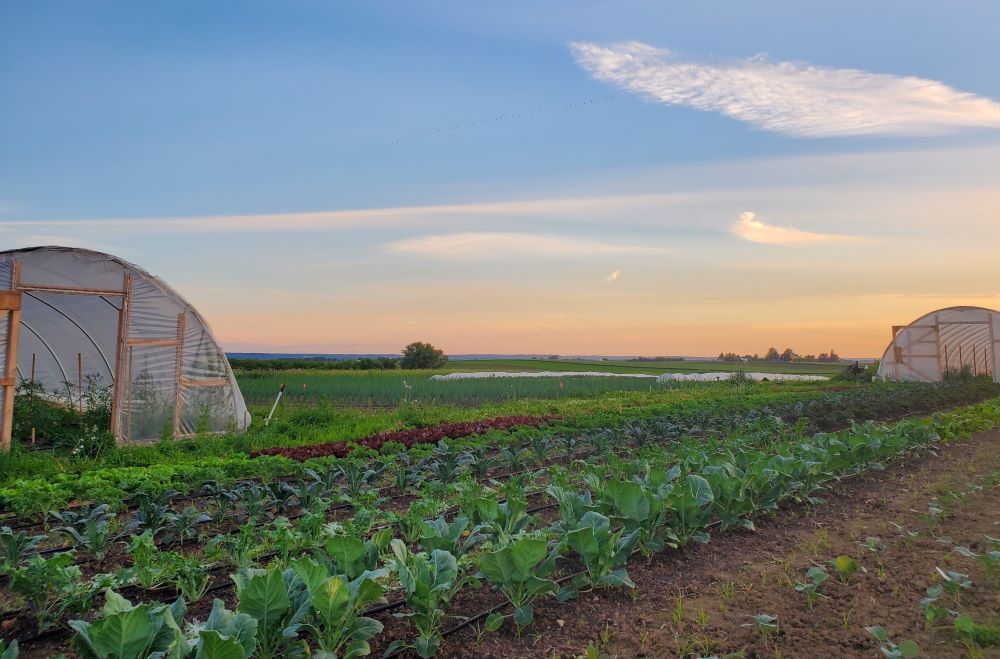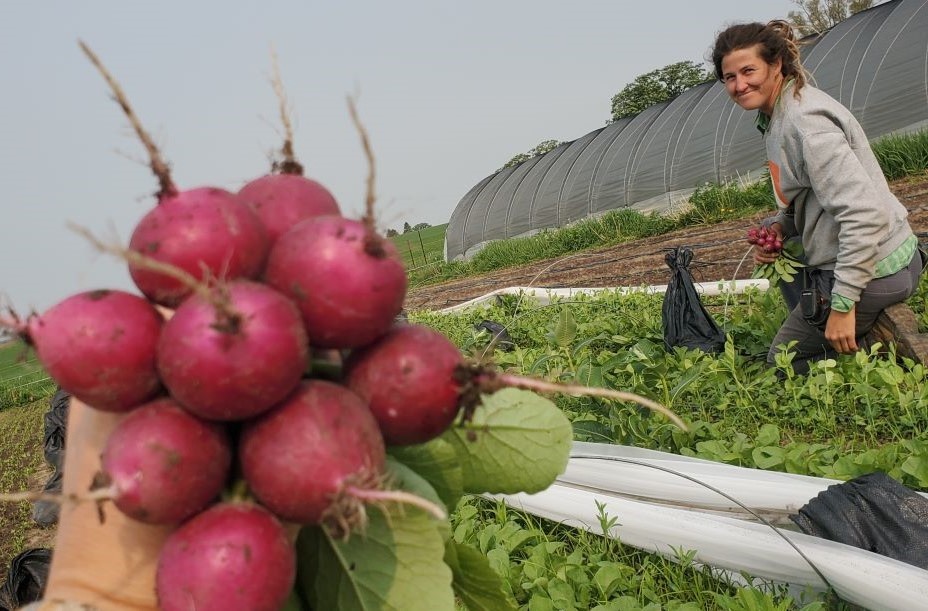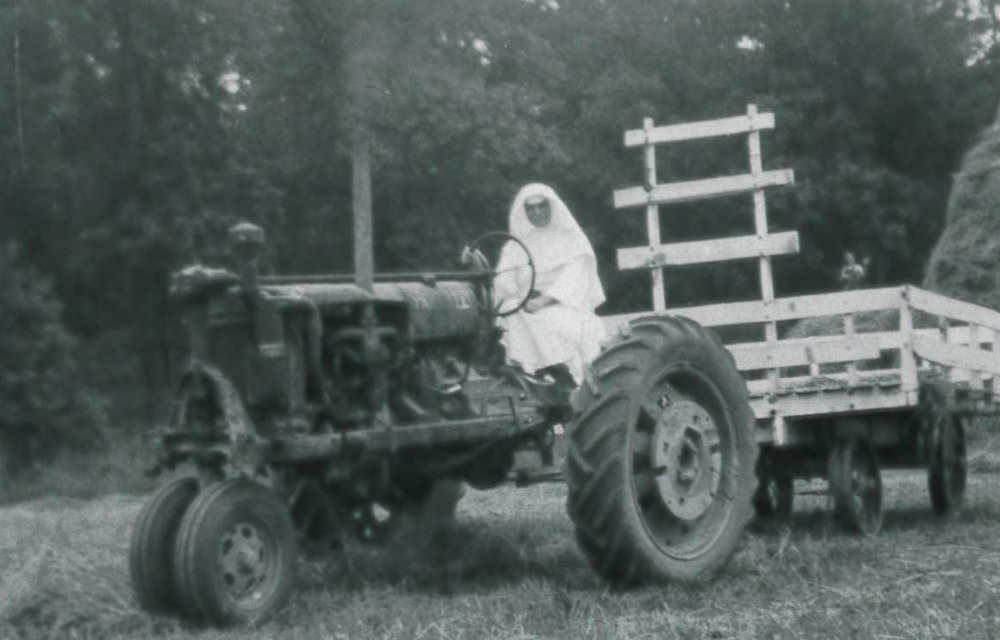
Ashley Neises, left, and Andie Donnan sell some of the produce they raise on Sandhill Farm, located at the Sinsinawa Mound Collaborative Farm, at area farmers markets. The collaborative farm is a program of the Dominican Sisters of Sinsinawa, Wisconsin. (Courtesy of Sandhill Farm)
From an acre of ground, organic farmers Andie Donnan and Ashley Neises grow enough produce — arugula, tomatoes, sweet corn, green beans and much more — to sell at area farmers markets, as well as to wholesale accounts like restaurants and dozens of customers of their community supported agriculture program, or CSA. This spring marks their seventh year as owners and operators of Sandhill Farm, on land they're renting from the Sinsinawa Mound Collaborative Farm, a project of the Dominican Sisters of Sinsinawa in southwestern Wisconsin.
The collaborative farm, begun in 2017, is approximately 4 acres of certified organic land, a fraction of the congregation's 450-acre property. Over 200 acres are in agricultural use, with the majority leased to a neighboring organic dairy farmer for grazing. More than 10 acres are established as prairie, and there is also a 10-acre swath of oak savanna.
Sinsinawa Mound is located 8 miles from Dubuque, Iowa, and 12 miles from Galena, Illinois. The area, with its tall bluffs, mounds and river-carved valleys, has long been an agricultural magnet, said Laurana Snyder, the farm's coordinator.

The Sinsinawa Mound Collaborative Farm has 4 acres of certified organic land, as well as equipment and facilities, available for rent to beginning farmers. (Courtesy of the Dominican Sisters of Sinsinawa)
"There's definitely been Native American movement through here. Not necessarily traditional agriculture, but they were tapping maple trees, fishing from the Mississippi River, and they probably planted some kind of produce around the mounds and came back to harvest when it was in season," Snyder said. "But with European settlement from 1820 onward, there has been some type of farming on the mounds."
Sinsinawa Dominican Sr. Julie Schwab, vicaress of the congregation and a member of its leadership council, said sisters have been farming the property since the congregation was established in 1847. In addition to raising crops, they also operated a dairy, which closed in 2004. Conventional farming using chemicals transitioned to organic methods. But as the sisters' numbers declined — from almost 2,000 in the 1960s to 255 today — farming became impractical, leaving the land fallow.
"We, like most congregations, believe the life force that flows through creation, through our land, through the animals, through humanity, is sacred. So we felt a strong obligation to care for the little part of earth that we happen to be on," Schwab said.

Rows of annual vegetable crops grow at Sandhill Farm. Ashley Neises and her partner, Andie Donnan, say that because of the high costs for beginning farmers, they would not have been able to start their farm without the program at the Sinsinawa Mound Collaborative Farm. (Courtesy of Sandhill Farm)
Surrounded by farmland, the congregation is aware of how small-scale farming is changing. U.S. Department of Agriculture data released in February shows the number of U.S. farms dropped from 2.04 million in 2017 to 1.9 million in 2022, while the average age of farmers has risen to 58 years, leading Agriculture Secretary Tom Vilsack to deem the statistics "a wake-up call."
New farmers often struggle with expenses that can lead to crippling debt. The price of cropland is rising, with an average cost of $5,460 an acre, according to a 2023 USDA report. One solution is incubator and collaborative farms, which help growers rent land and access equipment at reduced costs, giving them time to build up capital and experience. Boston's Tufts University Friedman School of Nutrition Science and Policy lists more than 200 incubator farms and apprenticeship programs across the U.S. in its National Incubator Farm Training Initiative network.

Sr. Julie Schwab is vicaress of the Dominican Sisters of Sinsinawa, Wisconsin. (Courtesy of Julie Schwab)
At Sinsinawa Mound Collaborative Farm, growers who apply for the program must have fewer than 10 years of farming experience. They can rent from an eighth of an acre to 2 acres of organic land. For the cost of monthly service fees, they can pick and choose from such available options as irrigation, farm equipment, greenhouses and cold storage. During the first year growers pay no rent or water fees. Each year, they decide whether to renew their lease. While rent gradually increases annually, it's capped after five years.
"It's a finely graduated system," Snyder said. "Theoretically you could do your first year of the collaborative for $200 or less, depending on whether you needed things like a greenhouse or a cooler."
"We had a plan when we started at the collaborative, and we were able to start our farm with less than $2,000," Neises said. "As far as the cost of land and the cost of vegetable production in general, we definitely would not have considered starting our farm without the collaborative being there. It wouldn't have been possible for us."

Ashley Neises harvests radishes, one of more than 40 different vegetables grown at Sandhill Farms. Neises and Andie Donnan run their farm on land they're renting from the Sinsinawa Mound Collaborative Farm, a project of the Dominican Sisters of Sinsinawa, Wisconsin. (Courtesy of Sandhill Farm)
Neises said many beginning farmers today either are part of an established family farm and inherit the land or have an off-farm job that allows them to purchase land, dividing their time between the farm and the second job.
"Or, as in our circumstances, you start a farm through a program like this and then you get off that land and try to find your own on a farm income," she said. "And a farm income is not necessarily what a bank thinks is appealing to lend to."
Neises and Donnan hope to eventually buy their own land. Both belong to Practical Farmers of Iowa, an organization offering financial incentive programs like matching funds for savings accounts.
Snyder said although the collaborative, unlike an incubator farm, allows growers to stay in the program indefinitely, she understands the model itself can set limits.
"Perennial crops are a little harder of a sell as part of a collaborative farm because perennials are in the ground forever," she said. "If you decide to leave or you find land, you can't take those with you as easily as you can annual vegetables. I don't know if anyone would really want to do an orchard because those trees are going to take upwards of five years before they really start producing."
The collaborative also offers resources for setting up business plans to determine the affordability of running a farm.
"It's one thing to know how to grow chard or green onions," Donnan said. "It is a whole other thing to develop systems and efficiencies so that you can actually afford to hire people to help you farm. To afford paying people — and yourself — means you have to take your business very seriously."

A Dominican sister guides a plow horse in a bean patch on the congregation’s farm in a photo dated 1947. (Courtesy of the Dominican Sisters of Sinsinawa)
This year, the Sinsinawa Dominicans are expanding their agricultural outreach with plans for a farmer-led education center, Fields of Sinsinawa. Over 200 farmers attended a recent conference about the project in Sinsinawa, Schwab said. She sees the center as a place for farmers to teach, as well as learn, at workshops and conferences on such topics as protecting and nurturing healthy soil, harvesting nutrient-dense food and cultivating community.
"Our interest is to create a place where any farmer, regardless of whether they're farming conventionally or organically, can come together to learn how to take better care of their land for the long future. We want to create a space where there's no finger-pointing, no judgment, but to come and learn better care for land," Schwab said.

Sisters have been farming their property in Sinsinawa, Wisconsin, since the congregation was founded in 1847. Here, a sister rides a tractor in a haying field in a photo dated August 1947. (Courtesy of the Dominican Sisters of Sinsinawa)
Inspiration came from Ohio farmer David Brandt, who promoted no-till agriculture, a farming method that limits plowing and uses cover crops to control erosion, reduce weeds and improve soil health. Schwab said meetings in Sinsinawa with Brandt before he died last year helped shape the farmer-led center's mission of not only protecting the environment, but ensuring profitability for farmers.
"Brandt is considered the grandfather of what we call regenerative agriculture," Schwab said. "If we just look at climate instability, we know all farmers need resiliency in their system. We believe regenerative agricultural practices help because the building up of the soil creates a resilience in the whole system."
Advertisement
She said farmers applying agricultural practices that use little or no chemical fertilizers or herbicides will see a reduction in expenses — meaning more income — even if their yield is lower.
"It's not saying, 'How much can we get out of this land? How much can we push and pull and force from this land?' Rather, the new goal for farmers is how we can better care for the soil and at the same time, take money to the bank," Schwab said. "If farming practices can help family farms to continue and to be successful, that's a mission match for us. We were founded as an educational congregation. The farmer-center is definitely a mission match for us as educators."
"There's a lot of potential for good in a group like this," said Beth Baranski, who leads the fundraising committee for Fields of Sinsinawa. "There's also a benefit to having a center at the mound. There's something about the place itself and the sisters there, the history of the sacredness for Indigenous people that changes the way we communicate with each other. And certainly change in agriculture is sometimes a tricky topic, but this place offers a sense of purpose."
Schwab said programs should start later this year. She hopes the center will draw farmers from the tri-state area and beyond.
"It's exciting because the potential is endless," she said. "Every farm around us is a different classroom. There's lots of learning ahead and we can learn from all our neighbors."









